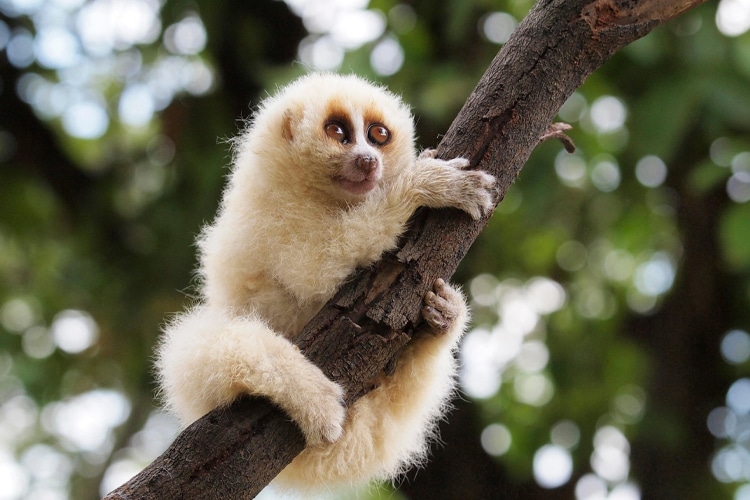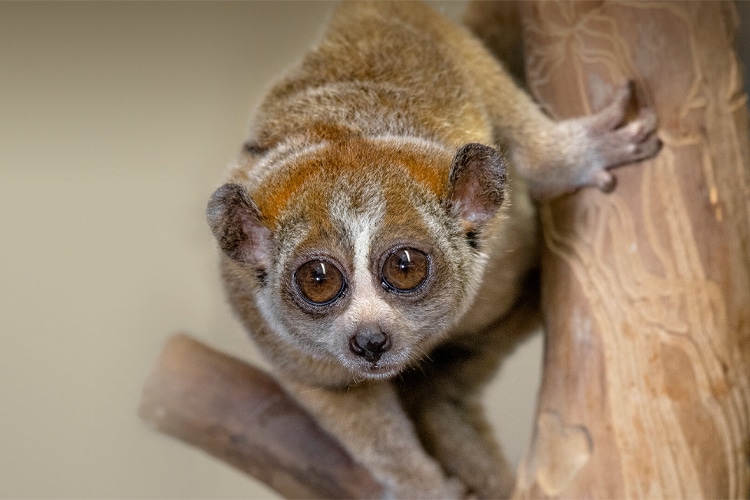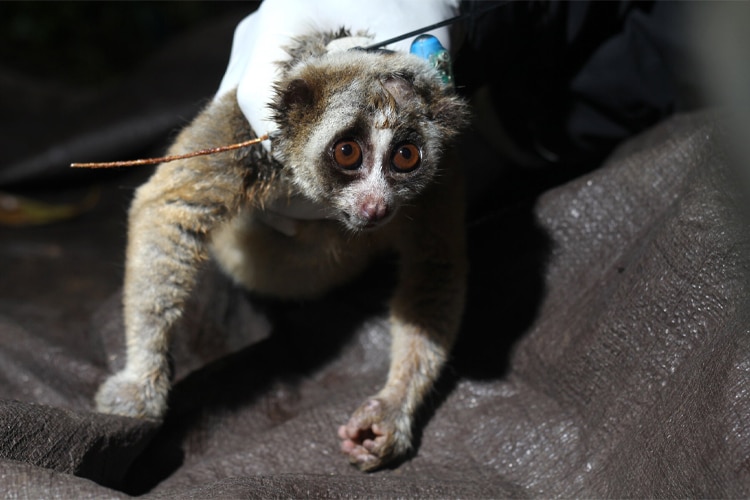The lovable but deadly slow loris monkeys, which are gaining popularity for their videos that go viral on the Internet, are a little-known member of the primate family. Known for their laziness and even called the lazy loris, these primates generally live in Southeast Asia.
The slow loris, which is at the bottom of the primate class and is the only venomous primate, is included in the list of mortars in danger of extinction. Due to the insufficient fossil record of the slow loris species, we do not have enough information about their evolutionary history.
What are the types of loris? What does the Slow Loris look like?
Some known species of loris are: Pygmy loris, sunda slow loris, javan slow loris, bengal slow loris, nycticebus floating loris, philippine slow loris. They have rather small dimensions. Their length varies from 7 to 40 cm. They have rounded heads, hairless ears, narrow noses, large eyes, and different color patterns depending on the species. Their fur is in shades of gray and brown. Their arms and legs are of equal length and they have very thin legs. Their trunks are quite long and flexible. Hands and feet are such that they can easily hang and grasp nearby branches. Loris do not have a tail.
Slow Loris sleeps during the day, awake at night
Thanks to their large eyes, they have good vision in low light, while they have blurry vision when the light is high. For this reason, loris live an active life at night and sleep during the day. They are known as nocturnal animals.
The second of the slow loris’ toes is smaller compared to the other toes to allow it to grip easily. Behind the retina of its large eyes is a layer called the tapetum lucidum, which allows the eye to both shine and see at night. Thanks to this layer, it is possible to say that loris can see better at night than many animals.
“If they want to walk, they get up and start walking”
Alan Knight, chief executive of the International Animal Rescue Team in England, said of slow loris: “Loris cannot run as fast as squirrels. They act like sloths. During our studies, even when moving the loris from one place to another, they wake up slowly and look around from the box they are in a drowsy state. If they feel like walking, they get up and start walking.” The movements of the slow loris resemble a snake. The scientific reason for this is that loris have more spinal vertebrae than other primates.
Lorisler developed various tactics for defense and protection.
Loris have other protection tactics besides their poisonous arms. Camouflage is one of the loris’ defense techniques. A loris guards its territory. As it tries to protect itself from other creatures, it will try to protect the area it is in from its own kind. The slow loris is a territorial animal.
If the venomous primate has nowhere to run and is literally cornered, it will bite its opponent. When it puts its teeth on an animal, it not only harms them, but also kidnaps other animals in the environment, thanks to the bad smell the poison produces. It is said that the smell that comes out is very sharp and indescribably bad.
Loris pretends to be a cobra to scare her enemies. This is his secret weapon. He slowly shakes his head from side to side, raising his arms and shoulders as if he were a cobra. The fur pattern of loris is similar to the skin of cobras. If they cannot frighten their enemies with their dance, the reptile will hiss and manage to frighten them.
Slow Loris are both carnivorous and herbivorous
The diet of these primates is very diverse. While some loris eat only fruit and trees, some loris can eat anything. There are both carnivorous and herbivorous species. One of the reasons why their diets differ so much is due to the variability of their habitat and conditions. Nycticebus Coucang has the longest tongue of all primates. He uses this tongue to drink the juice in the fruit.
While some loris species survive only in tropical forests, some species can live in savanna climate or dry forests. Just like their movements, the development of loris is quite slow compared to other night creatures and they complete their development in a long time.
Loris hide poison in their arms
Other than humans, their other predators are orangutans, hawks, eagles and snakes. They stand still when attacked. They can lick the secretion obtained from a gland in their arms and combine it with their saliva to obtain poison. They keep predators away, thanks to the venom they produce. They get this poison in their arm from the hundreds of poisonous bugs they eat in the forest.
At the same time, they can protect the baby loris by applying this poison to their fur. If you were to be bitten by a slow loris, you would start to feel a lot of edema and intense pain throughout your body. According to the Indonesian people, the bite of a snake is much less painful than the bite of a loris.
Indonesian unlucky loris
It is thought that the evolution of loris began in Africa, and a group of loris progressed towards the center of Asia, evolving into the slow loris we are talking about. Lazy loris fight for survival in a wide area covering Northeast India, Bangladesh and southeast Asia.
The loris who live in the Indonesian Forests have been given spiritual features by the locals there. For this reason, they believe that they will cook the unlucky and endangered loris, and believe that they will live a longer life thanks to their blood, and eat them by roasting them in a wood fire.
It is also said that corpses of lazy loris are buried under many highways. They believe that buried loris corpses will prevent accidents on these roads. In some regions, loris are known to use some parts of their bodies for medicinal purposes.
They can reach a depth of 12 meters by digging.
Slow loris can dig burrows 1 to 12 meters deep in place. They can spend time in these cavities they dig and at the same time find their food while opening these cavities. These primates, which are active at night, spend their days sleeping. Compared to male loris, female loris have smaller habitats. Contrary to what would be expected, the slow loris can travel up to 8 kilometers in a single night.
Loris communicate with the smell of urine
They can make rather weak sounds. They communicate through urine odors and follow each other. One loris can follow another loris by smelling urine. The slow loris can see 3200 square meters from its location and has 60 different sleeping spots.
Unfortunately, loris are also sacrificed for human commercial purposes.
Slow loris videos, which are thought to be cute and circulating a lot on social networks, have increased people’s interest in these primates. Slow loris are traded by people who turn this increasing interest into an opportunity. Ignoring the fact that its habitat is forests and wooded areas, there are quite a lot of people trying to use loris as pets, which are unofficially traded for high prices.
Those who watch videos of loris being tickled by humans on the internet cannot realize the terrible situation behind this video. The reason for this movement of the loris, whose arms rise higher as they are tickled in the videos, is that they use the passive defense mechanism. Perceiving the tickling movement as a danger and attack, she gets panic and fear. While these primates, which are poisonous by nature, are traded, their teeth are extracted with cutting tools and prepared like a product, without any local anesthesia, so that the buyer does not bite.
As the name suggests, catching very slow-moving loris has become quite easy for those who do this trade. Some of the loris whose teeth were removed die from infection at this stage. Although many loris are not infected, they die while being transported in tightly packed closed boxes. 9 different species of these venomous primates, which are in the category of endangered animals, are known, and it is known that only 8 species are still alive today and 1 species is completely extinct.



















